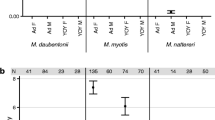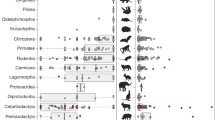Abstract
Characterizing host traits that influence viral richness and diversification is important for understanding wildlife pathogens affecting conservation and/or human health. Behaviors that affect contact rates among hosts could be important for viral diversification because more frequent intra- and inter-specific contacts among hosts should increase the potential for viral diversification within host populations. We used published data on bats to test the contact-rate hypothesis. We predicted that species forming large conspecific groups, that share their range with more heterospecifics (i.e., sympatry), and with mating systems characterized by high contact rates (polygynandry: multi-male/multi-female), would host higher viral richness than species with small group sizes, lower sympatry, or low contact-rate mating systems (polygyny: single male/multi-female). Consistent with our hypothesis and previous research, viral richness was positively correlated with conspecific group size although the relationship plateaued at group sizes of approximately several hundred thousand bats. This pattern supports epidemiological theory that, up to a point, larger groups have higher contact rates, greater likelihood of acquiring and transmitting viruses, and ultimately greater potential for viral diversification. However, contrary to our hypothesis, there was no effect of sympatry on viral richness and no difference in viral richness between mating systems. We also found no residual effect of host phylogeny on viral richness, suggesting that closely related species do not necessarily host similar numbers of viruses. Our results support the contact-rate hypothesis that intra-specific viral transmission can enhance viral diversification within species and highlight the influence of host group size on the potential of viruses to propagate within host populations.


Similar content being viewed by others
References
Altizer S, Nunn C, Thrall P, et al (2003) Social organization and parasite risk in mammals: Integrating theory and empirical studies. Annu Rev Ecol Evol Syst 34:517–547. doi: 10.1146/annurev.ecolsys.34.030102.151725
Anthony SJ, Epstein JH, Murray KA, et al (2013) A strategy to estimate unknown viral diversity in mammals. MBio 4:e00598-13. doi: 10.1128/mBio.00598-13.Editor
Antia R, Regoes RR, Koella JC, Bergstrom CT (2003) The role of evolution in the emergence of infectious diseases. Nature 426:658–661. doi:10.1038/nature02177.1.
Bininda-Emonds ORP, Cardillo M, Jones KE, et al (2007) The delayed rise of present-day mammals. Nature 446:507–513. doi:10.1038/nature05634
Blomberg S., Garland T, Ives AR (2003) Testing for phylogenetic signal in comparative data: behavioral traits are more labile. Evolution 57:717–45.
Blomberg SP, Garland T (2002) Tempo and mode in evolution: phylogenetic inertia, adaptation and comparative methods. J Evol Biol 15:899–910.
Bordes F, Blumstein DT, Morand S (2007) Rodent sociality and parasite diversity. Biol Lett 3:692–694. doi:10.1098/rsbl.2007.0393
Boyles JG, Cryan PM, Mccracken GF, Kunz TH (2011) Economic importance of bats in agriculture. Science 332 (80):41–42. doi:10.1126/science.1201366
Brierley L, Vonhof MJ, Olival KJ, et al (2016) Quantifying global drivers of zoonotic bat viruses: A process-based perspective. Am Nat 187:E53–E64. doi:10.1086/684391
Burnham KP, Anderson DR (2002) Model selection and multimodel inference, 2nd edn. Springer, New York
Chen L, Liu B, Yang J, Jin Q (2014) DBatVir: The database of bat-associated viruses. Database 2014:1–7. doi:10.1093/database/bau021
Clutton-Brock TH (1989) Mammalian mating systems. Proceedings of the Royal Society of London B: Biological Sciences 236:339–372. doi:10.1098/rspb.1989.0027
Craft ME, Caillaud D (2011) Network models: An underutilized tool in wildlife epidemiology? Interdiscip Perspect Infect Dis. doi:10.1155/2011/676949
Daszak P, Plowright RK, Epstein JH, et al (2006) The emergence of Nipah and Hendra virus: Pathogen dynamics across a wildlife-livestock-human continuum. In: Disease ecology: Community Structure and Pathogen Dynamics, pp 186–201
Dietz K (1993) The estimation of the basic reproduction number for infectious diseases. Stat Methods Med Res 2:23–41. doi:10.1177/096228029300200103
Ezenwa VO, Price SA, Altizer S, et al (2006) Host traits and parasite species richness in even and odd-toed hoofed mammals, Artiodactyla and Perissodactyla. Oikos 115:526–536. doi:10.1111/j.2006.0030-1299.15186.x
Gay N, Olival KJ, Bumrungsri S, et al (2014) Parasite and viral species richness of Southeast Asian bats: Fragmentation of area distribution matters. Int J Parasitol 3:161–170. doi:10.1016/j.ijppaw.2014.06.003
Gortazar C, Reperant LA, Kuiken T, et al (2014) Crossing the Interspecies Barrier: Opening the Door to Zoonotic Pathogens. PLoS Pathog 10:e1004129. doi:10.1371/journal.ppat.1004129
Hamede RK, Bashford J, McCallum H, Jones M (2009) Contact networks in a wild Tasmanian devil (Sarcophilus harrisii) population: Using social network analysis to reveal seasonal variability in social behaviour and its implications for transmission of devil facial tumour disease. Ecol Lett 12:1147–1157. doi:10.1111/j.1461-0248.2009.01370.x
Holmes EC, Drummond AJ (2007) The evolutionary genetics of viral emergence. In: Wildlife and Emerging Zoonotic Diseases: The Biology, Circumstances and Consequences of Cross-Species Transmission, Childs JE, Mackenzie JS, Richt JA (editors), Berlin, Heidelberg: Springer, pp 51–66
IUCN (2012) IUCN Red List of Threatened Species. Version 2012.1. http://www.iucnredlist.org. Accessed 1 Mar 2013
Jones KE, Bielby J, Cardillo M, et al (2009) PanTHERIA: a species-level database of life history, ecology, and geography of extant and recently extinct mammals. Ecology 90:2648.
Jones KE, Purvis A, MacLarnon A, et al (2002) A phylogenetic supertree of the bats (Mammalia: Chiroptera). Biol Rev 77:223–59.
Kalka MB, Smith AR, Kalko EKV (2008) Bats limit arthropods and herbivory in a tropical forest. Science 320(80):71–72. doi:10.1126/science.1153352
Kerth G (2008) Causes and consequences of sociality in bats. Bioscience 58:737–746. doi:10.1641/B580810
Lausen CL, Barclay RMR (2006) Benefits of living in a building: big brown bats (Eptesicus fuscus) in rocks versus buildings. J Mammal 87:362–370. doi:10.1644/05-MAMM-A-127R1.1
Lewis SE (1995) Roost Fidelity of Bats: A Review. J Mammal 76:481–496. doi:10.2307/1382357
Lindenfors P, Nunn CL, Jones KE, et al (2007) Parasite species richness in carnivores: Effects of host body mass, latitude, geographical range and population density. Glob Ecol Biogeogr 16:496–509. doi:10.1111/j.1466-8238.2006.00301.x
Luis AD, Hayman DTS, O’Shea TJ, et al (2013) A comparison of bats and rodents as reservoirs of zoonotic viruses: are bats special? Proc R Soc B 280:20122753. Doi:10.1098/rspb.2012.2753
Luis AD, O’Shea TJ, Hayman DTS, et al (2015) Network analysis of host-virus communities in bats and rodents reveals determinants of cross-species transmission. Ecol Lett 18:1153–1162. doi:10.1111/ele.12491
Maine JJ, Boyles JG (2015) Bats initiate vital agroecological interactions in corn. Proc Natl Acad Sci 112:12438–12443. doi:10.1073/pnas.1505413112
McCracken GF, Wilkinson GS (2000) Bat Mating Systems. In: Chrichton EG, Krutzsch PH (eds) Reproductive Biology of Bats. Academic Press, San Diego, USA, pp 321–362
Morse SS, Mazet JAK, Woolhouse M, et al (2012) Prediction and prevention of the next pandemic zoonosis. Lancet 380:1956–1965. doi:10.1016/S0140-6736(12)61684-5
Nunn CL, Altizer SM, Sechrest W, Cunningham AA (2005) Latitudinal gradients of parasite species richness in primates. Divers Distrib 11:249–256. doi:10.1111/j.1366-9516.2005.00160.x
Nunn CL, Jordan F, McCabe CM, et al (2015) Infectious disease and group size: more than just a numbers game. Philos Trans R Soc B Biol Sci 370:20140111–20140111. doi:10.1098/rstb.2014.0111
Nunn CL, Scully EJ, Kutsukake N, et al (2014) Mating Competition, Promiscuity, and Life History Traits as Predictors of Sexually Transmitted Disease Risk in Primates. Int J Primatol 35:764–786. doi:10.1007/s10764-014-9781-5
Nunn CL, Thrall PH, Stewart K, Harcourt AH (2008) Emerging infectious diseases and animal social systems. Evol Ecol 22:519–543. doi:10.1007/s10682-007-9180-x
Olival KJ, Hosseini PR, Zambrana-torrelio C, et al (2017) Host and viral traits predict zoonotic spillover from mammals. Nature 546:646–650. doi:10.1038/nature22975
Paradis E, Blomberg S, Bolker B, et al. (2017) Package “ape”: Analyses of Phylogenetics and Evolution
Pedersen AB, Davies TJ (2010) Cross-species pathogen transmission and disease emergence in primates. Ecohealth 6:496–508. doi:10.1007/s10393-010-0284-3
Plowright RK, Eby P, Hudson PJ, et al (2015) Ecological dynamics of emerging bat virus spillover. Proc R Soc B 282:20142124.
Pulliam JRC (2008) Viral host jumps: Moving toward a predictive framework. Ecohealth 5:80–91. doi:10.1007/s10393-007-0149-6
R Development Core Team (2016) R: A Language and Environment for Statistical Computing. R Foundation. https://www.r-project.org/.
Revell LJ (2012) phytools: An R package for phylogenetic comparative biology (and other things). Methods Ecol Evol 3:217–223. doi:10.1111/j.2041-210X.2011.00169.x
Ryder JJ, Miller MR, White A, et al (2007) Host-parasite population dynamics under combined frequency- and density-dependent transmission. Oikos 116:2017–2026. doi:10.1111/j.2007.0030-1299.15863.x
Serra-Cobo J, López-Roig M, Seguí M, et al (2013) Ecological Factors Associated with European Bat Lyssavirus Seroprevalence in Spanish Bats. PLoS One 8:e64467. doi:10.1371/journal.pone.0064467
Simmons NB (2005) Order chiroptera. In: Mammal Species of the World: A Taxonomic and Geographic Reference. John Hopkins University Press, pp 312–529
Tian L, Liang B, Maeda K, et al (2004) Molecular studies on the classification of Miniopterus schreibersii (Chiroptera: Vespertilionidae) inferred from mitochondrial cytochrome b sequences. Folia Zool 53:303–311.
Tompkins DM, Dunn AM, Smith MJ, Telfer S (2011) Wildlife diseases: From individuals to ecosystems. J Anim Ecol 80:19–38. Doi:10.1111/j.1365-2656.2010.01742.x
Turmelle AS, Olival KJ (2009) Correlates of viral richness in bats (Order Chiroptera). Ecohealth 6:522–539. doi:10.1007/s10393-009-0263-8
VanderWaal KL, Ezenwa VO (2016) Heterogeneity in pathogen transmission: mechanisms and methodology. Funct Ecol 30:1606–1622. doi:10.1111/1365-2435.12645
Webber QMR, Brigham RM, Park AD, et al (2016) Social network characteristics and predicted pathogen transmission in summer colonies of female big brown bats (Eptesicus fuscus). Behav Ecol Sociobiol. doi:10.1007/s00265-016-2093-3
Wilkinson GS (1985) The social organization of the common vampire bat: II Mating system, genetic structure, and relatedness. Behav Ecol Sociobiol 17:123–134.
Acknowledgements
We thank Kevin Olival, two anonymous reviewers, and members of The University of Winnipeg Bat Lab for outstanding comments on earlier drafts of this manuscript. Funding was provided to CKRW from the Natural Sciences and Engineering Research Council (NSERC, Canada), an NSERC Post-Doctoral Fellowship to QEF and a Manitoba Graduate Scholarship to QMRW.
Author information
Authors and Affiliations
Corresponding author
Electronic supplementary material
Below is the link to the electronic supplementary material.
10393_2017_1276_MOESM1_ESM.png
Supplementary Figure S1. Summary of the group size for each bat species (n = 51) in our database. Note that data were log-transformed for ease of interpretation although y-axis shows corresponding untransformed values. (PNG 446 kb)
10393_2017_1276_MOESM2_ESM.png
Supplementary Figure S2. Summary of the total number of publications for each bat species (n = 51) in our database. Note the majority of research (right side of figure) has been conducted on temperate bats while less research (left side of figure) has been conducted on tropical bats. (PNG 483 kb)
Rights and permissions
About this article
Cite this article
Webber, Q.M.R., Fletcher, Q.E. & Willis, C.K.R. Viral Richness is Positively Related to Group Size, but Not Mating System, in Bats. EcoHealth 14, 652–661 (2017). https://doi.org/10.1007/s10393-017-1276-3
Received:
Revised:
Accepted:
Published:
Issue Date:
DOI: https://doi.org/10.1007/s10393-017-1276-3




